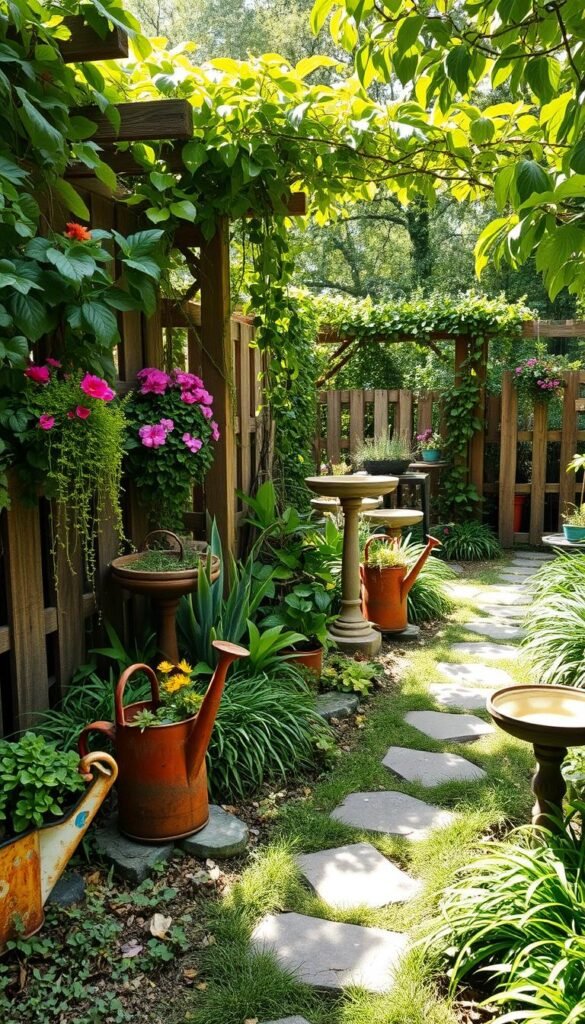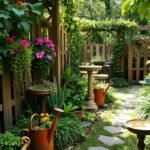Did you know U.S. landfills received enough trash in 2018 to fill 40,000 Olympic swimming pools? That eye-opening statistic shows why rethinking waste matters. Turning discarded items into functional garden elements helps reduce this staggering environmental burden while adding character to your yard.
You don’t need fancy supplies to create an eco-friendly oasis. Old pallets become vertical planters. Chipped teacups transform into whimsical bird feeders. Even broken concrete pieces make charming stepping stones. Every repurposed item tells a story while keeping usable materials out of landfills.
This approach does more than help the planet – it saves money and sparks creativity. Neighbors will admire your unique benches made from salvaged wood or colorful borders crafted from bottle caps. Your space becomes a conversation starter that demonstrates how sustainability and style work together.
Through simple projects, you’ll discover how everyday objects gain new life outdoors. We’ll explore practical ways to blend environmental care with smart design, proving that beautiful spaces don’t require expensive materials – just imagination and resourcefulness.
Transform Your Garden with Eco-Friendly Recycled Materials
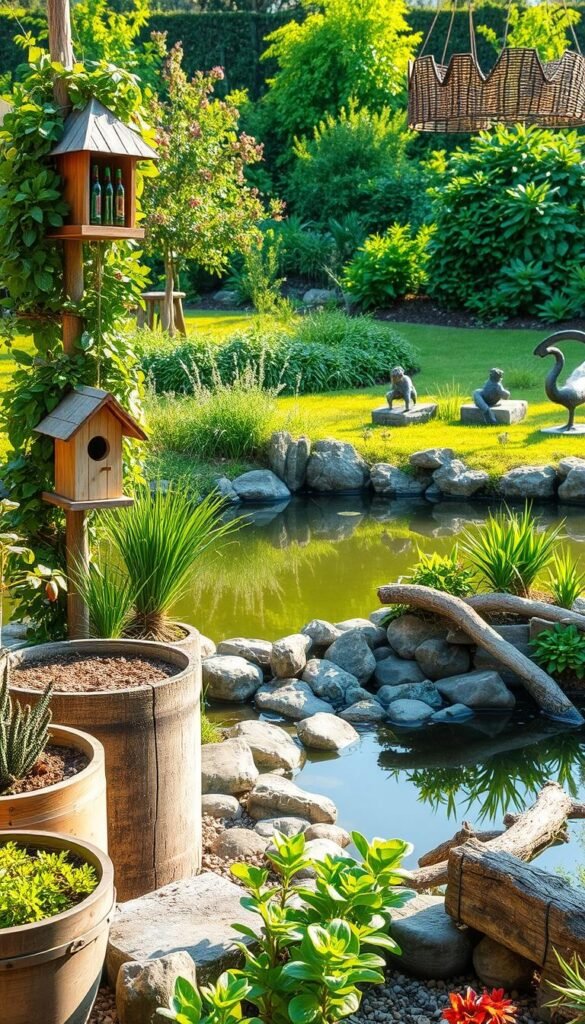
Every time you reuse an old bucket or broken tile outdoors, you’re doing more than just saving money. Repurposing materials cuts energy use by up to 95% compared to manufacturing new products. This ripple effect makes your green choices far bigger than your backyard.
Discover the Environmental Impact of Everyday Objects
When you turn jars into herb planters or use bricks as path borders, you shrink your carbon footprint. Fewer factories churn out plastic pots. Less fuel transports store-bought decor. Over time, these small acts add up to cleaner air and healthier soil.
Craft a Space That Speaks to You
That chipped birdbath from a vintage gardening makeover? It’s not just decor—it’s a chapter in your landscape’s story. Neighbors might compliment your tire-shaped flower beds, but the real win is knowing each piece reflects your values.
“Good design whispers before it shouts,” says landscape artist Mara Holt. Your upcycled creations prove beauty doesn’t need price tags—just perspective. An old ladder becomes a vertical garden. Cracked plates form mosaic tables. With every project, you redefine what “waste” really means.
Innovative Ways to Use Recycled Materials in Your Garden
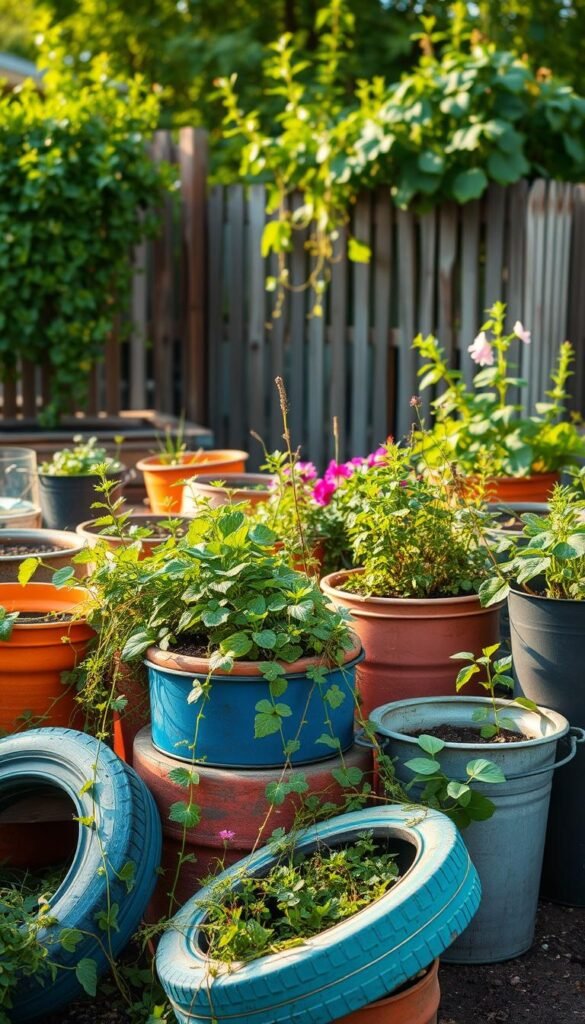
What if your old kitchen tools could become the stars of your outdoor space? Everyday objects gain new purpose when paired with soil and greenery. Let’s explore how ordinary items transform into extraordinary features that benefit both your garden and the planet.
Creative Planters From Household Items
That chipped colander collecting dust? Drill holes become drainage ports. Fill it with herbs for a hanging display. Bathroom fixtures like sinks and tubs make striking containers for trailing flowers—their porcelain surfaces reflect sunlight beautifully.
Don’t toss worn-out boots! Line them with landscape fabric, add soil, and plant succulents. Pair them with a broken wheelbarrow filled with marigolds for a playful vignette. Even cracked teacups can host mini cacti arrangements on your patio table.
Repurposing Wooden Pallets, Tires, and Plastic Bottles
Wooden pallets shine as vertical gardens. Lean one against a wall, add potting mix to the slats, and insert strawberry plants. Stack painted tires to create tiered planters for tomatoes or petunias—their rubber retains heat for faster growth.
Plastic bottles become self-watering systems. Cut them horizontally, poke drainage holes, and nestle the top half into the base. This creates a reservoir that keeps soil moist for days. Group several along a fence for a cascading herb wall.
| Material | Project | Key Benefit |
|---|---|---|
| Wooden Pallets | Vertical Garden | Maximizes small spaces |
| Tires | Tiered Planters | Durable & weather-resistant |
| Plastic Bottles | Self-Watering System | Reduces watering frequency |
| Kitware | Herb Planters | Upcycles discarded items |
These ways to reuse materials prove that imagination trumps budget. Your garden becomes a living gallery where sustainability meets personal style—one repurposed piece at a time.
Sustainable DIY Projects for a Greener Garden
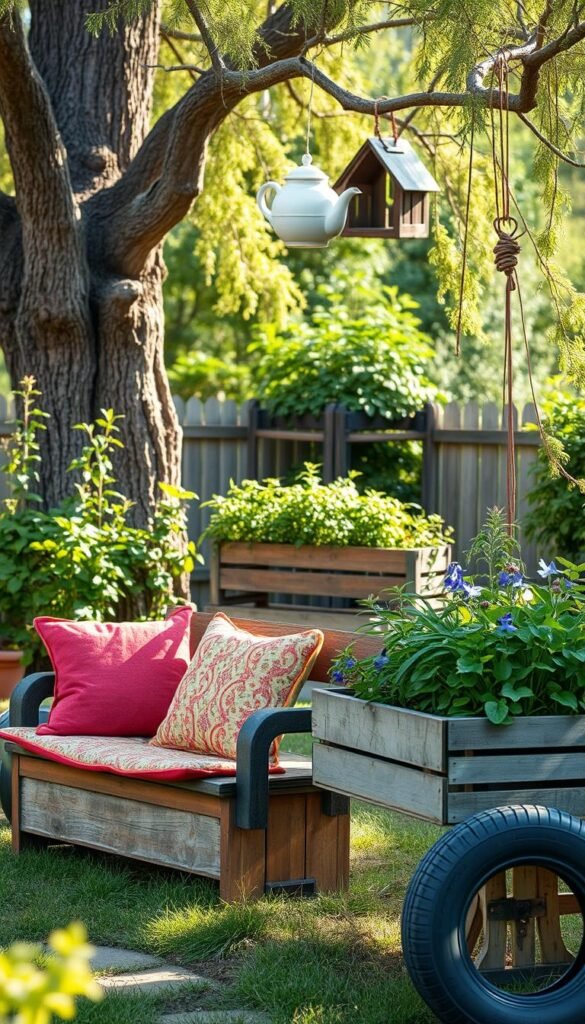
Your empty bottles and old paint cans hold untapped potential for eco-friendly garden upgrades. Simple modifications turn these items into functional tools that nurture plants and wildlife while cutting waste. Let’s explore clever ways to build practical systems using what you already own.
Mini Greenhouses & Self-Watering Planters
Transform a 5-gallon water jug into a protective dome for seedlings. Cut off the bottom and place it over young plants to trap warmth and moisture. For thirsty herbs, repurpose wine bottles as watering devices. Bury the neck of an inverted bottle near roots – it’ll release water gradually as soil dries.
Backyard Bird Sanctuaries & Irrigation
Turn paint cans into vibrant bird feeders by adding perches and filling them with seeds. For a budget-friendly container gardening irrigation hack, poke holes in a 2-liter soda bottle. Attach it to your hose for a homemade sprinkler that waters small areas evenly.
| Project | Materials | Key Benefit | Difficulty |
|---|---|---|---|
| Mini Greenhouse | Water jug | Protects seedlings | Easy |
| Self-Watering Planter | Wine bottle | Reduces watering | Moderate |
| Bird Feeder | Paint can | Attracts pollinators | Easy |
| Bottle Sprinkler | Soda bottle | Affordable irrigation | Easy |
These DIY solutions prove you don’t need expensive gear to create a thriving outdoor space. Each project gives discarded items new purpose while supporting your local ecosystem.
Ideas for Incorporating Recycled Materials in Your Garden Design
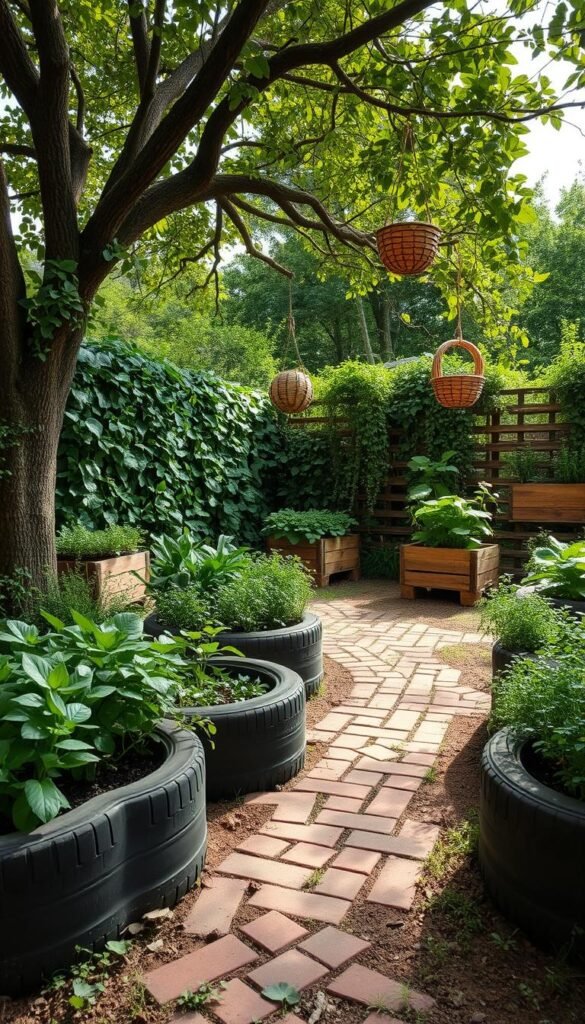
What if your backyard could fight climate change? Every repurposed brick and salvaged plank helps shrink waste streams while crafting unique outdoor spaces. This approach transforms your plot into an environmental asset through smart material reuse.
Powerful Benefits Beyond Your Property Line
Recycled gardening cuts landfill contributions while saving resources. For every ton of concrete reused, you prevent 1,360 pounds of sand extraction. Native plant gardens using reclaimed containers support 3x more pollinators than conventional setups.
Earth-Conscious Landscaping Strategies
Build gabion walls with demolition debris instead of buying new stone. Create gravel paths using crushed concrete from landscaping projects – it lasts longer than fresh aggregate. Fallen trees become free benches when local woodworkers shape them.
Try these water-smart techniques:
- Rain gardens filter storm runoff through layered gravel and native plants
- Xeriscaping reduces irrigation needs by 60% with drought-resistant species
- Dry-stack stone borders encourage beneficial insects to nest
Upcycled container solutions let you grow herbs in colanders while salvaged doors become vertical plant walls. Your space becomes a living lesson in sustainability – where beauty and responsibility grow side by side.
Eco-Friendly Tips for a Personalized and Sustainable Garden
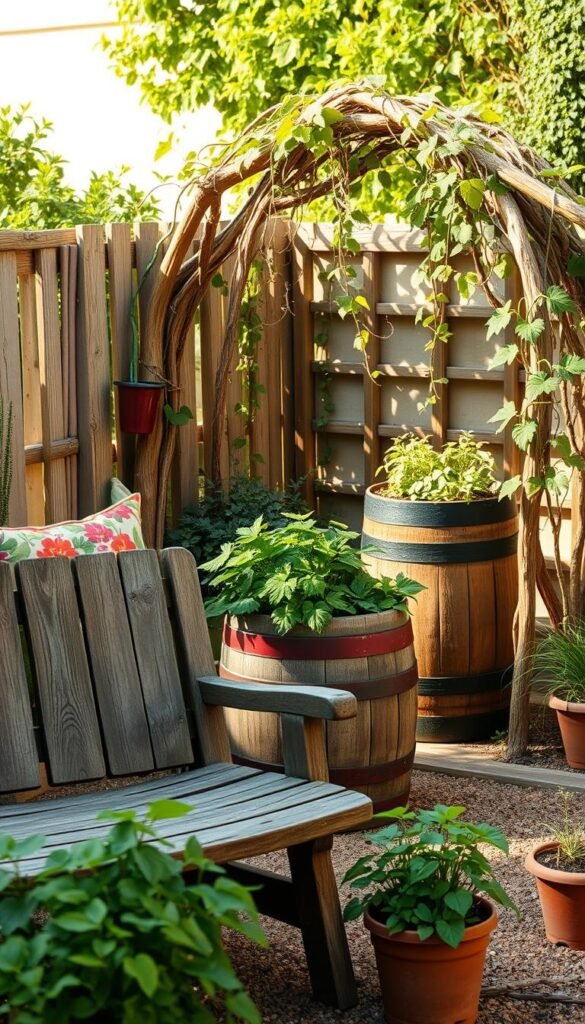
Your morning coffee grounds could be the secret to vibrant hydrangeas. By blending upcycled furniture with smart composting, you create spaces that nourish plants and express your style. This approach turns forgotten items into functional art while keeping organic waste from landfills.
Breathing New Life Into Forgotten Treasures
Convert that vintage dresser into a cascading herb display. Drill drainage holes in alternate shelves, fill them with soil, and plant thyme or basil. Old desks become perfect potting stations—store tools in drawers and use the surface for transplanting seedlings.
Try these creative conversions:
- Turn chipped teacups into succulent planters for patio tables
- Stack painted drawers as tiered strawberry containers
- Use bed frames as climbing rose supports
Composting Made Simple
Transform kitchen scraps into compost gold with a three-bin system. Layer coffee grounds with vegetable peels and dried leaves—this mix creates nutrient-rich fertilizer in 8-12 weeks. Avoid meat or greasy items to prevent odors.
| Compost Yes | Compost No |
|---|---|
| Coffee grounds | Meat scraps |
| Eggshells | Dairy products |
| Fruit peels | Pet waste |
Enhance drainage in repurposed pots by adding broken tile pieces at the base. Your garden becomes a living testament to sustainability—where every salvaged chair and compost heap tells an eco-conscious story.
Wrapping Up Your Green Journey
Your garden now tells a story where creativity meets purpose. Every repurposed container and salvaged wooden pallet reduces waste while adding character to your space. You’ve mastered turning egg cartons into seed starters and transforming plastic bottles into self-watering planters – skills that grow more valuable each season.
Working with garden designers? Share your vision early. Many professionals now prioritize sustainable materials, whether building soil-rich raised beds from old sinks or crafting pathways with broken concrete. Start projects by auditing what you already own – that unused bin or stack of paper grocery bags might hold unexpected potential.
Maintenance remains simple: water flowers in upcycled containers as you would store-bought pots. Nurture plants in wooden pallet planters with the same care as conventional gardens. Your efforts create cleaner air and inspire neighbors to rethink their own scraps and cartons.
This journey proves eco-conscious choices don’t limit beauty – they redefine it. Your thriving oasis shows how everyday items gain new life, proving that thoughtful design and environmental care always blossom together.

